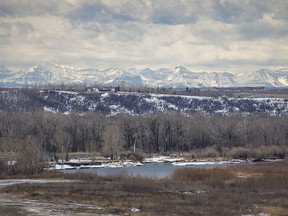
Article content
There was still a lot of snow in the fields to the east.
But it was melting fast.
Article content
This latest dump of snow — no, not the one that’s falling as I type this — had been followed by a few days of warm sun and was now fading away, giving its precious moisture to the fields and pastures on the flat lands along the Bow River. But here, for now, there was plenty of it left.
There was also plenty of standing water left from the last melt. Flocks of geese were splashing around in it, though in places all I could see were their heads, while squadrons of wigeons and pintails blasted back and forth. Deer were out in the fields, their forms shimmering in the heat ripples caused by the bright sun.
Advertisement 2
Article content
All of that which was pretty interesting. But I had actually come out this way to see what was happening along the river.
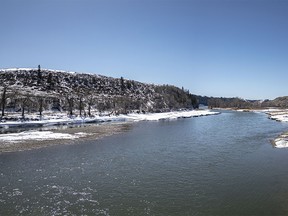
A lot of the moisture from this snow, plus a huge portion from everything upstream, ends up flowing into and down the Bow River. It’s a big river, at least by our standards, and it carries a lot of water from the mountains into the South Saskatchewan River and onward to Hudson Bay. Above Calgary it runs more like a mountain stream, especially the stretches above and between the various dams that slow and store its flow.
But the part that interests me the most is the stretch between the city and the Carseland irrigation weir. This is where it becomes a hybrid of mountain stream and prairie river, where it flows fast, cold and mostly clear over gravel shelves and sandstone slabs, between canyon walls where the south-facing slopes host cactus and sage while the north-facing slopes hold water birch and spruce.
It is a fascinating stretch of riverine wonder but it has been mostly sleeping through the winter months. Now, with spring here — despite the snow — it is waking up. And I wanted to have a look as it comes out of its nap.
Advertisement 3
Article content
So I headed down toward Carseland.
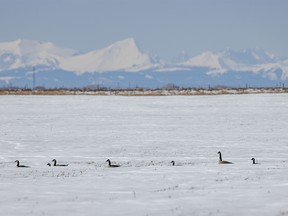
The snow cover here was a bit of a surprise but a welcome one. With drought worries so prevalent, any moisture, whether in the form of snow or rain, is good, especially since the Carseland weir channels a good chunk of the Bow into the irrigation system that fills downstream canals and reservoirs. But while that moisture was helping the land, it was turning the roads into muck.
They weren’t slushy like they had been in the foothills the week before but they were a morass of mud and ruts. Luckily, though, the steepest part of the descent down to the Legacy Island boat launch just west of Carseland is partially paved so, once I slid my way along the mud slicks on the snowy benchlands above the river, I had an easy drive down to the water and a dry way back up.
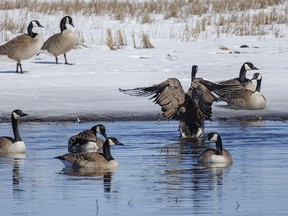
I hadn’t expected the river to be so open here. The last time I’d had a look, maybe a month ago, the braided channels here were choked with ice. Now, though, the ice was confined to the exposed gravel bars and spots here and there along the shore so I grabbed my camera and walked over to have a look.
And, flopped down with my camera aimed at the water dripping from one of those bankside slabs, is where the fly-casters startled me.
Article content
Advertisement 4
Article content
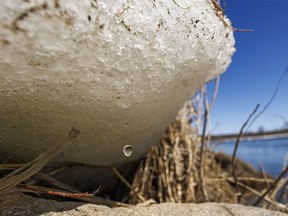
I was so concentrated on trying to time my shutter to the water drops that I didn’t hear them until they were just couple of feet behind me. My heart nearly leapt from my throat as I suddenly heard voices and turned around to see them standing over me just a few feet away. Although some of that could have been embarrassment from them seeing me in such an undignified position.
They were nice folks about to embark on a float down the river to see how the fishing was so I asked if they’d mind if I flew my little drone over them as they started their journey. They told me to go right ahead.
Turns out the fishing was pretty good. They’d barely made a couple of casts when they caught and released a gorgeous big rainbow trout. Folks, I hope your day turned out great. And thanks for the pictures!
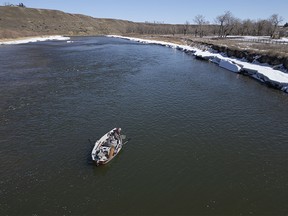
I hung around the river bottom there for a few minutes more, listening to all the bird song and the rustle of the dry cottonwood leaves in the riverine forest before coming back out of the valley and heading downstream toward the weir.
Where I stopped at the top of the valley.
I almost always stop here because the view down onto the river is spectacular. The river braids and meanders among islands as the water backs up behind the weir and creates a huge variety of forest and wetland that the birds and animals love.
Advertisement 5
Article content
But today I stopped for another reason. The road here is steep and washboarded from all the traffic. And, unlike the way down to Legacy, it isn’t paved. Looking down the slope I could see big puddles and slimy-looking mud, enough that I nearly turned around.
But I didn’t. Can’t say I was glad I decided to go down the road but once I was at the bottom and by the river, things were better.
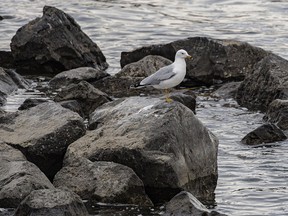
The river was ice-free here, too, with hardly any ice along the shore. Ring-billed and California gulls were flying back and forth looking for things to eat while Canada geese and various ducks paddled the open water or rested on the ice still remaining in the backwaters. Plenty of folks fishing, too, and I saw trout rippling the water half a dozen times.
But the roads through the river bottom were atrocious so I just had a cursory look around before heading back out of the valley, spinning my tires in the muck on the steep parts, and sloshing back toward town. My friend Les was going to work on my brakes the next morning so rather than cake even more mud into the wheel wells and the undercarriage, I opted to get back and hit a car wash so he wouldn’t have to deal with the mess.
Advertisement 6
Article content
The next day, Tuesday, Les quickly replaced my front brake pads — the rears were still OK— and I was back on the road and headed toward the river again.
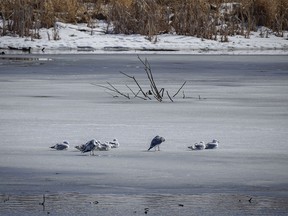
This time, I made my first stop close to the city, dropping down to the water at Policeman’s Flats. The parking lot there was full, both with boat trailers waiting for folks floating from the city as well as people here to hike around or fish the banks.
There weren’t many birds around, probably because of all the people, but I saw a couple geese perched incongruously on a cottonwood across the river. And near them, a sure sign of spring.
There was at least one pair of blue herons back on a nest in the rookery across the river. I had to use my longest lens to see them but those lanky fish-and-frog pokers are back. So nice to have them here.
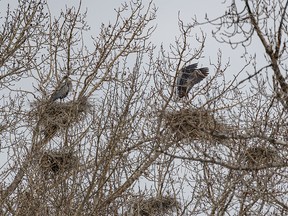
Snow still abounded in the fields as I headed east toward Carseland again along the south side of the river but once I got there, I had a bit of a surprise.
What a change a day made. Most of the snow had melted out by Carseland and the roads, though still soft, had dried up. The slab of ice I’d crawled under at Legacy Island had melted enough that it had collapsed and I could actually see the pond where I’d only seen the heads of the geese on it before.
Advertisement 7
Article content
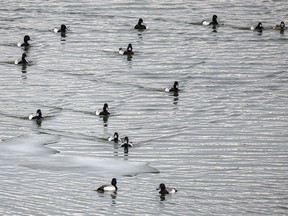
Over at the weir, there were dozens more ducks, these ones mostly scaup with their black and white bodies and blue bills. The ice shelf that had filled the backwater above the weir was now a third smaller than just the day before and the scaup were diving for food on the river bottom at the shelf’s end closest to the shore.
The weather had changed, too. Gone was the bright sunshine of the day before and in was thick chinook cloud. It was just as warm, maybe even a tad warmer, and the combination of that warmth and the chinook breeze had dried up the roads down by the weir considerably.
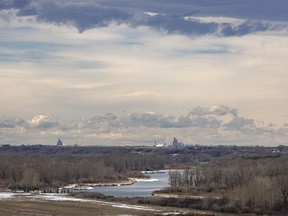
There seemed to be more birds in and around the water though that could be because the wind was keeping them closer. The willows and saskatoons along the shore were full of sparrows and I saw two separate flocks of mergansers paddling in the calmer waters. The gulls were hanging closer to the weir and the sheltered bends in the river as they hunted but the geese were flapping around and honking in pairs pretty much everywhere.
Unexpectedly, a pair of male pheasants in their blazingly bold mating colours came trotting out of the bankside brush right by the weir and stood around long enough for both photos and video.
Advertisement 8
Article content
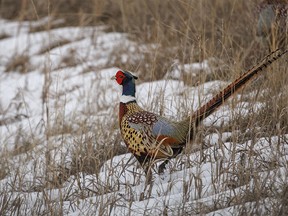
There were eagles flying around, one landing in the trees by a heron rookery. And on the water, folks fishing everywhere. By mid-afternoon, the light had taken on that warm tone that chinook cloud often brings and it looked more like evening than three hours before suppertime.
Which I didn’t mind at all.
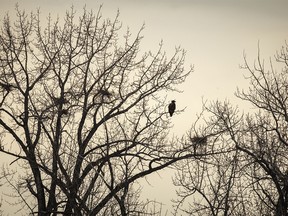
Slabs of ice broken off from shelves upstream idled down the current while trout dimpled the amber-tinted surface. The soft, warm light heightened the reds of the willow stems and the browns of saskatoons and chokecherry thickets. It turned the pale yellow of the poplar and aspen trunks to cream.
And that dark chinook arch over everything made it feel like the sun was about to go down.
It wasn’t but I decided to leave anyway. There was one more place I wanted to check before I rolled back to town so I pulled out of the valley and headed west.
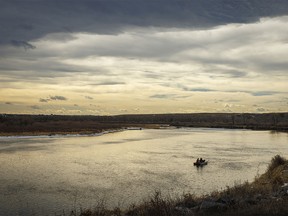
McKinnon Flats is the only river access point that closes for the winter but even though I knew the gate was still locked — it opens April 15 — I figured I’d park and walk over to the edge of the valley.
Never made it.
Just a few kilometres from the gate I found several hundred tundra and trumpeter swans along with hundreds of wigeons and pintails covering a mucky field. They were everywhere, walking through the mud, splashing in the meltwater ponds, flying overhead. Magnificent.
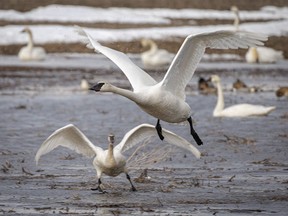
Just like the Bow and everything around it.
The water these birds were splashing in, the snow falling on the mountains and flats around the river again today, the birds and animals that live here year-round or just call the valley their seasonal neighbourhood, all contribute to what we call the Bow River.
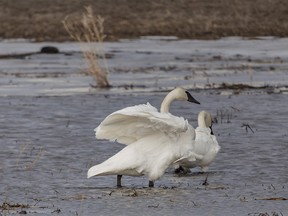
The Bow River that has been sleeping for a while, waiting for the spring alarm to ring.
Which it has.
And the Bow is ready to roll again.
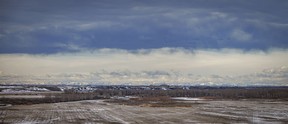
Article content



